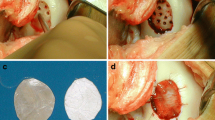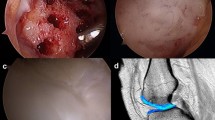Abstract
Articular cartilage defects heal poorly. Autologous Matrix-Induced Chondrogenesis (AMIC) is an innovative treatment for localized full-thickness cartilage defects combining the well-known microfracturing with collagen scaffold and fibrin glue. The purpose of this prospective study was to evaluate the medium-term results of this enhanced microfracture technique for the treatment of chondral lesions of the knee. Thirty-two chondral lesions in 27 patients were treated with AMIC. Within the context of clinical follow-up, these patients were evaluated for up to 5 years after the intervention. Five different scores (Meyer score, Tegner score, Lysholm score, ICRS score, Cincinatti score) as well as radiographs were used for outcome analysis. Articular resurfacing was assessed by magnetic resonance imaging (MRI). The average age of patients (11 females, 16 males; mean body mass index 26, range 20–32) was 37 years (range 16–50 years). The mean defect size of the chondral lesions was 4.2 cm2 (range 1.3–8.8 cm2). All defects were classified as grade IV according to the Outerbridge classification. The follow-up period was between 24 and 62 months with a mean of 37 months. Twenty out of 23 individuals (87%) questioned were subjectively highly satisfied with the results after surgery. Significant improvement (P < 0.05) of all scores was observed as early as 12 months after AMIC, and further increased values were notable up to 24 months postoperatively. MRI analysis showed moderate to complete filling with a normal to incidentally hyperintense signal in most cases. Results did not show a clinical impact of patient’s age at the time of operation, body mass index and number of previous operations (n.s.). In contrast, males showed significant higher values in the ICRS score compared to their female counterparts. AMIC is an effective and safe method of treating symptomatic full-thickness chondral defects of the knee in appropriately selected cases. However, further studies with long-term follow-up are needed to determine whether the grafted area will maintain structural and functional integrity over time.






Similar content being viewed by others
References
Behrens P (2005) Matrixgekoppelte Mikrofrakturierung. Arthroskopie 18:193–197
Behrens P, Bitter T, Kurz B, Russlies M (2006) Matrix-associated autologous chondrocyte transplantation/implantation (MACT/MACI)–5-year follow-up. Knee 13:194–202
Bentley G, Biant LC, Carrington RW, Akmal M, Goldberg A, Williams AM, Skinner JA, Pringle J (2003) A prospective, randomised comparison of autologous chondrocyte implantation versus mosaicplasty for osteochondral defects in the knee. J Bone Joint Surg Br 85:223–230
Bliddal H, Boesen M, Christensen R, Kubassova O, Torp-Pedersen S (2008) Imaging as a follow-up tool in clinical trials and clinical practice. Best Pract Res Clin Rheumatol 22:1109–1126
Boyer KA, Beaupre GS, Andriacchi TP (2008) Gender differences exist in the hip joint moments of healthy older walkers. J Biomech 41:3360–3365
Briggs KK, Steadman JR, Hay CJ, Hines SL (2009) Lysholm score and tegner activity level in individuals with normal knees. Am J Sports Med 37:898–901
Brittberg M, Lindahl A, Nilsson A, Ohlsson C, Isaksson O, Peterson L (1994) Treatment of deep cartilage defects in the knee with autologous chondrocyte transplantation. N Engl J Med 331:889–895
Browne JE, Anderson AF, Arciero R, Mandelbaum B, Moseley JB Jr, Micheli LJ, Fu F, Erggelet C (2005) Clinical outcome of autologous chondrocyte implantation at 5 years in US subjects. Clin Orthop Relat Res 436:237–245
Cerynik DL, Lewullis GE, Joves BC, Palmer MP, Tom JA (2009) Outcomes of microfracture in professional basketball players. Knee Surg Sports Traumatol Arthrosc 17:1135–1139
Chiang H, Jiang CC (2009) Repair of articular cartilage defects: review and perspectives. J Formos Med Assoc 108:87–101
Dhollander AA, Huysse WC, Verdonk PC, Verstraete KL, Verdonk R, Verbruggen G, Almqvist KF (2009) MRI evaluation of a new scaffold-based allogenic chondrocyte implantation for cartilage repair. Eur J Radiol [Epub ahead of print]
Dorotka R, Windberger U, Macfelda K, Bindreiter U, Toma C, Nehrer S (2005) Repair of articular cartilage defects treated by microfracture and a three-dimensional collagen matrix. Biomaterials 26:3617–3629
Gille J, Meisner U, Ehlers EM, Muller A, Russlies M, Behrens P (2005) Migration pattern, morphology and viability of cells suspended in or sealed with fibrin glue: a histomorphologic study. Tissue Cell 37:339–348
Hunziker EB, Stahli A (2008) Surgical suturing of articular cartilage induces osteoarthritis-like changes. Osteoarthritis Cartilage 16:1067–1073
Irrgang JJ, Ho H, Harner CD, Fu FH (1998) Use of the international knee documentation committee guidelines to assess outcome following anterior cruciate ligament reconstruction. Knee Surg Sports Traumatol Arthrosc 6:107–114
Knutsen G, Drogset JO, Engebretsen L, Grontvedt T, Isaksen V, Ludvigsen TC, Roberts S, Solheim E, Strand T, Johansen O (2007) A randomized trial comparing autologous chondrocyte implantation with microfracture. Findings at five years. J Bone Joint Surg Am 89:2105–2112
Kramer J, Bohrnsen F, Lindner U, Behrens P, Schlenke P, Rohwedel J (2006) In vivo matrix-guided human mesenchymal stem cells. Cell Mol Life Sci 63:616–626
Kreuz PC, Muller S, Ossendorf C, Kaps C, Erggelet C (2009) Treatment of focal degenerative cartilage defects with polymer-based autologous chondrocyte grafts: four-year clinical results. Arthritis Res Ther 11:R33
Kreuz PC, Steinwachs M, Erggelet C, Lahm A, Krause S, Ossendorf C, Meier D, Ghanem N, Uhl M (2007) Importance of sports in cartilage regeneration after autologous chondrocyte implantation: a prospective study with a 3-year follow-up. Am J Sports Med 35:1261–1268
Kreuz PC, Steinwachs MR, Erggelet C, Krause SJ, Konrad G, Uhl M, Sudkamp N (2006) Results after microfracture of full-thickness chondral defects in different compartments in the knee. Osteoarthritis Cartilage 14:1119–1125
Lee CR, Breinan HA, Nehrer S, Spector M (2000) Articular cartilage chondrocytes in type I and type II collagen-GAG matrices exhibit contractile behavior in vitro. Tissue Eng 6:555–565
Marlovits S, Singer P, Zeller P, Mandl I, Haller J, Trattnig S (2006) Magnetic resonance observation of cartilage repair tissue (MOCART) for the evaluation of autologous chondrocyte transplantation: determination of interobserver variability and correlation to clinical outcome after 2 years. Eur J Radiol 57:16–23
Minas T (2001) Autologous chondrocyte implantation for focal chondral defects of the knee. Clin Orthop Relat Res 391:349–361
Minas T, Gomoll AH, Rosenberger R, Royce RO, Bryant T (2009) Increased failure rate of autologous chondrocyte implantation after previous treatment with marrow stimulation techniques. Am J Sports Med 37:902–908
Mithoefer K, McAdams T, Williams RJ, Kreuz PC, Mandelbaum BR (2009) Clinical efficacy of the microfracture technique for articular cartilage repair in the knee: an evidence-based systematic analysis. Am J Sports Med 37:2053–2063
Nehrer S, Breinan HA, Ramappa A, Shortkroff S, Young G, Minas T, Sledge CB, Yannas IV, Spector M (1997) Canine chondrocytes seeded in type I and type II collagen implants investigated in vitro. J Biomed Mater Res 38:95–104
Niemeyer P, Pestka JM, Kreuz PC, Erggelet C, Schmal H, Suedkamp NP, Steinwachs M (2008) Characteristic complications after autologous chondrocyte implantation for cartilage defects of the knee joint. Am J Sports Med 36:2091–2099
Ossendorf C, Kaps C, Kreuz PC, Burmester GR, Sittinger M, Erggelet C (2007) Treatment of posttraumatic and focal osteoarthritic cartilage defects of the knee with autologous polymer-based three-dimensional chondrocyte grafts: 2-year clinical results. Arthritis Res Ther 9:R41
Outerbridge RE (1961) The etiology of chondromalacia patellae. J Bone Joint Surg Br 43-B:752–757
Peterson L, Minas T, Brittberg M, Nilsson A, Sjogren-Jansson E, Lindahl A (2000) Two- to 9-year outcome after autologous chondrocyte transplantation of the knee. Clin Orthop Relat Res 374:212–234
Rosenberger RE, Gomoll AH, Bryant T, Minas T (2008) Repair of large chondral defects of the knee with autologous chondrocyte implantation in patients 45 years or older. Am J Sports Med 36:2336–2344
Rosenstein AD, Veazey B, Shephard D, Xu KT (2008) Gender differences in the distal femur dimensions and variation patterns in relation to TKA component sizing. Orthopedics 31:652
Russlies M, Behrens P, Ehlers EM, Brohl C, Vindigni C, Spector M, Kurz B (2005) Periosteum stimulates subchondral bone densification in autologous chondrocyte transplantation in a sheep model. Cell Tissue Res 319:133–142
Steadman JR, Rodkey WG, Briggs KK (2002) Microfracture to treat full-thickness chondral defects: surgical technique, rehabilitation, and outcomes. J Knee Surg 15:170–176
Steinwachs M (2009) New technique for cell-seeded collagen matrix-supported autologous chondrocyte transplantation. Arthroscopy 25:208–211
Trattnig S, Ba-Ssalamah A, Pinker K, Plank C, Vecsei V, Marlovits S (2005) Matrix-based autologous chondrocyte implantation for cartilage repair: noninvasive monitoring by high-resolution magnetic resonance imaging. Magn Reson Imaging 23:779–787
Welsch GH, Trattnig S, Scheffler K, Szomonanyi P, Quirbach S, Marlovits S, Domayer S, Bieri O, Mamisch TC (2008) Magnetization transfer contrast and T2 mapping in the evaluation of cartilage repair tissue with 3T MRI. J Magn Reson Imaging 28:979–986
Wright RW (2009) Knee injury outcomes measures. J Am Acad Orthop Surg 17:31–39
Acknowledgments
Written consent for publication was obtained from the patient or their relative. The authors would like to thank Katja Martin for reviewing the early manuscript.
Author information
Authors and Affiliations
Corresponding author
Rights and permissions
About this article
Cite this article
Gille, J., Schuseil, E., Wimmer, J. et al. Mid-term results of Autologous Matrix-Induced Chondrogenesis for treatment of focal cartilage defects in the knee. Knee Surg Sports Traumatol Arthrosc 18, 1456–1464 (2010). https://doi.org/10.1007/s00167-010-1042-3
Received:
Accepted:
Published:
Issue Date:
DOI: https://doi.org/10.1007/s00167-010-1042-3




